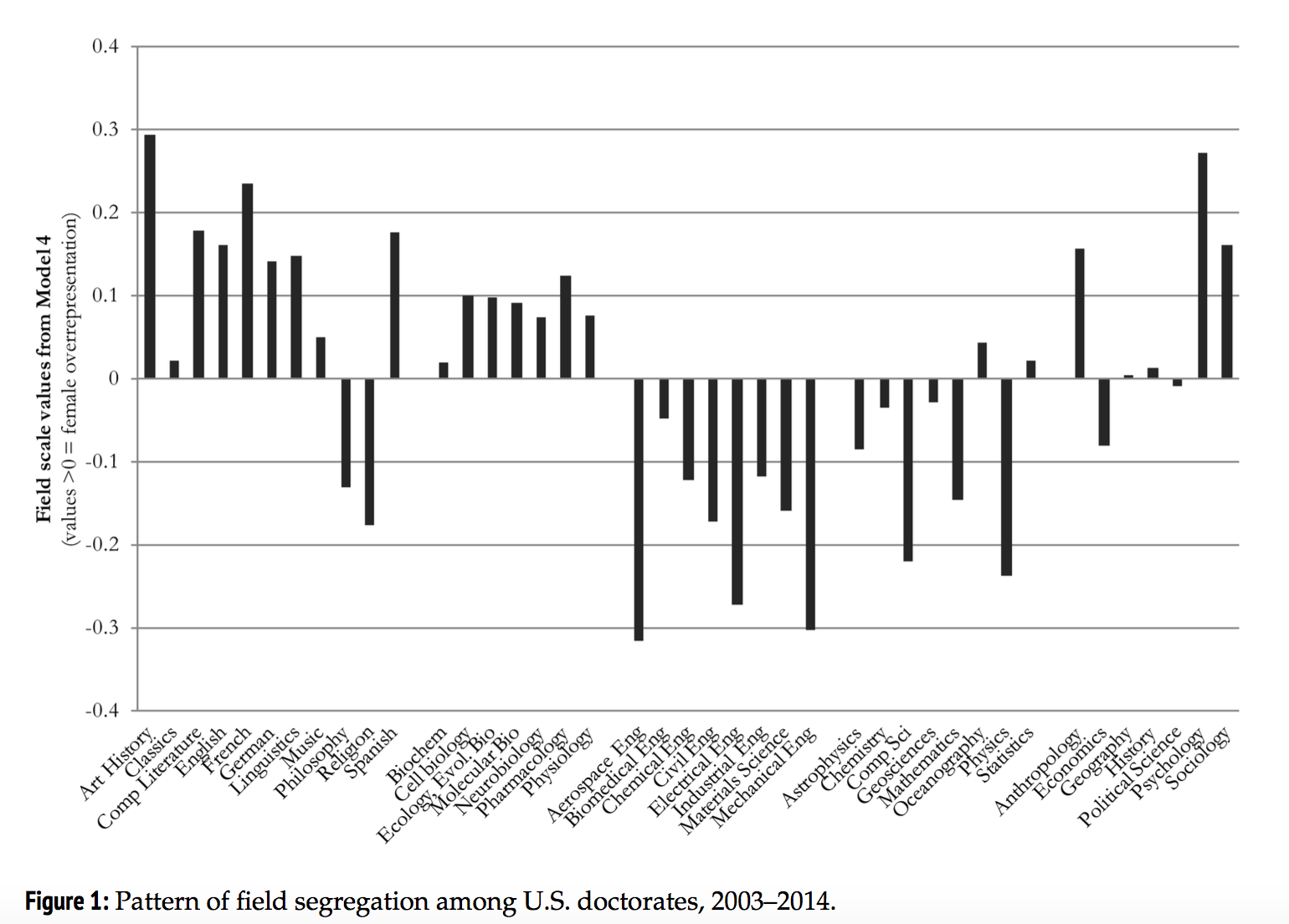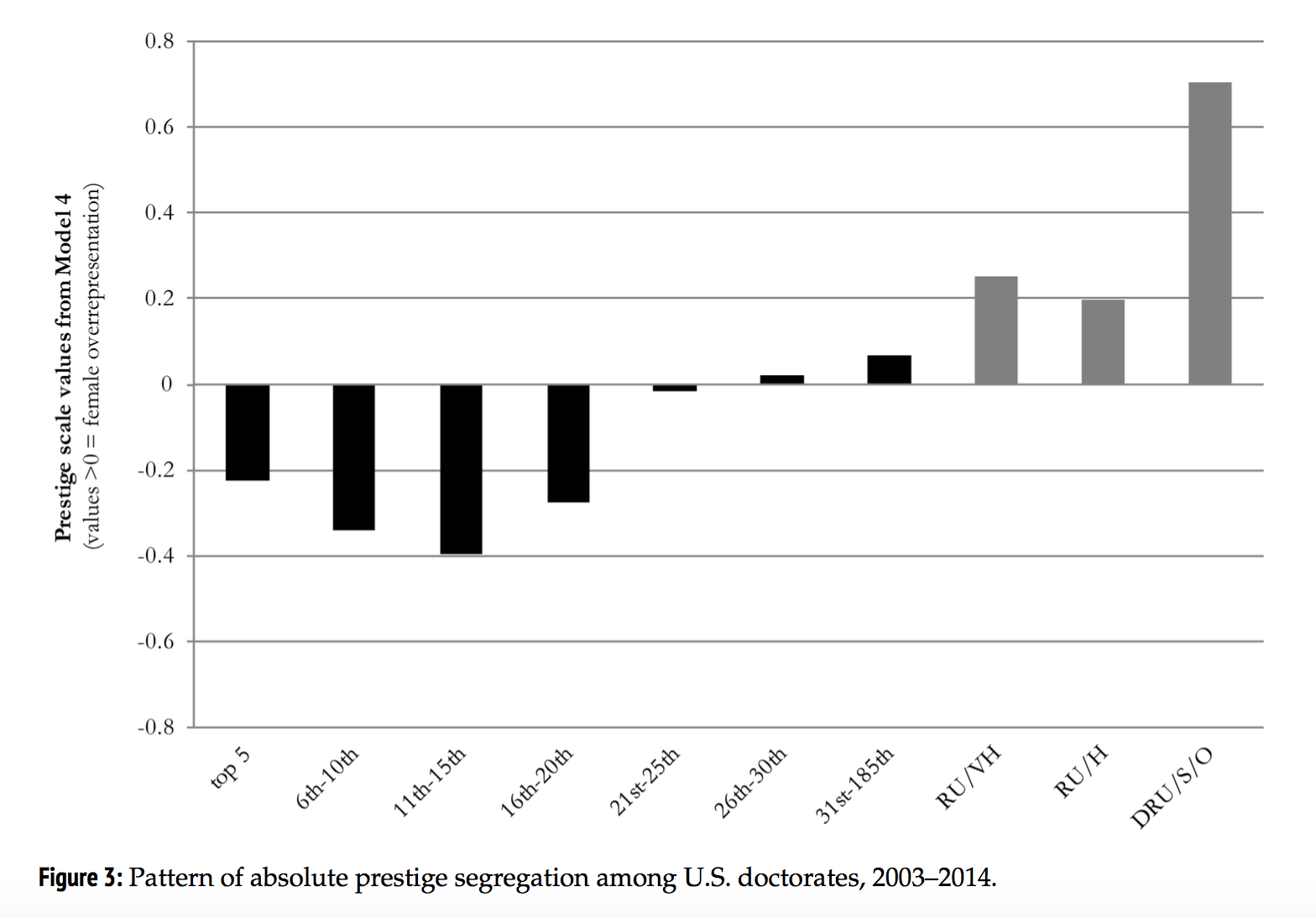You have /5 articles left.
Sign up for a free account or log in.

Getty Images
Women earn 60 percent of baccalaureate degrees and 46 percent of doctoral degrees, excluding professional programs, according to 2015 data from the National Science Foundation, yet they’re still underrepresented in many disciplines. Why? A new study points to segregation by gender based on field of study and what it calls program prestige.
“Prestige segregation is weaker than field segregation but substantively important,” the paper asserts. “On average, between 11 and 13 percent of female doctoral students would need to ‘trade’ programs with men in order to eliminate prestige segregation.”
Averaged across all fields and adjusting for field segregation, men are overrepresented in the most elite programs by a factor of 1.06. But overrepresentation in many fields is substantially higher, according to the study, with the most segregated field, mathematics, approaching a male overrepresentation factor of 1.5. “A 6 percent male advantage in elite representation in the average program, up to a 50 percent advantage in some especially prestige-segregated fields, is a nontrivial gender disparity,” the paper says.
Beyond prestige segregation -- measured using program rankings by the National Research Council -- the paper suggests that field segregation in doctoral education is pronounced, follows a similar pattern as segregation at the undergraduate level and is strongly associated with field-level skills -- namely math and language.
“Close to two-thirds of the net association between gender and field is captured by a five-category measure of math skills,” the paper says. “This disparity could, of course, reflect differences in the student populations (primarily undergraduate vs. exclusively graduate), in the measures of skill, or in modeling strategies. If there is indeed more skill-based gender segregation in graduate education than in undergraduate education, the sources of these disparities warrant further research.”
“Degrees of Difference: Gender Segregation of U.S. Doctorates by Field and Program Prestige” was written by Kim A. Weeden, Jan Rock Zubrow ’77 Professor of the Social Sciences and chair of sociology at Cornell University; Sarah Thébaud, assistant professor of sociology at the University of California, Santa Barbara; and Dafna Gelbgiser, a postdoctoral fellow at the Center for the Study of Inequality at Cornell. It was published this week in Sociological Science.
Using program-level data on earned doctorates from 2003-14 from the federal Integrated Postsecondary Education Data System and the research council's 1995 rankings of doctoral programs, the study’s authors awarded each program an absolute and relative prestige score. Institution type was also considered, and gender ratios for each field were calculated.
Comparing the math and verbal skills of the 41 research council fields with the average 2008 math and verbal Graduate Record Examination scores of test takers intending to go to graduate school in a given field of study, the authors constructed categorical variables differentiating five skill groups.
Eventually they matched most of the 3,271 programs ranked by the research council to the 5,132 programs listed in IPEDS as granted degrees in council research fields. Last, they cross-classified arrays of field, program prestige and gender from the merged data.
The authors were unsurprised to see that gender segregation by field in doctoral education is extensive, with men or women overrepresented in the average field by a factor of 2.12, and a third of male or female doctorates needing to change their disciplines for men and women to receive the same percentage of Ph.D.s in all fields.

Prestige segregation was weaker, but still “substantively significant,” according to the paper. Some 12 percent of male or female doctorates would need to change programs to achieve full integration, it says, with men or women overrepresented by a factor of 1.29.
Assessing the relationship between field segregation and skills via various models, the authors found that 65 percent of disciplinary imbalances by gender are associated with math skills, as measured by GRE scores, which were lower on average for women. The association for verbal skills was just 19 percent.
Regarding prestige segregation, the authors’ analysis suggests that men are overrepresented in programs in the top three deciles but especially in the top decile. Women’s representation, meanwhile, “increases toward the middle of the prestige distribution, reaching its peak among ranked programs in the 71-80th percentile bucket.”
Men’s representation increases again in the bottom two prestige groups, but not to the same extent as male overrepresentation in the top two decile groups.

In another model, men were overrepresented in the top prestige groups, while women’s representation increased as ranking declined.
Looking at both program and cross-disciplinary difference by gender, math skills account for about 15 percent of the total field-level variation in the strength of prestige segregation, the paper says, while verbal skill shift effects account for about 22 percent. So field-level skills “contribute only modestly to observed differences in the strength of prestige segregation.”
Discipline by discipline, another model showed that women are underrepresented in the highest-prestige programs in most, but not all, fields. Top-decile programs are male dominated in 27 of the 41 research council-ranked fields, female dominated in four fields -- Spanish, biomedical engineering, materials engineering and geography -- and gender neutral in the remaining 10 fields.
Male overrepresentation in the top decile programs is particularly strong in economics, in which men are overrepresented by a factor of 1.27, and mathematics, where men are overrepresented by a factor of 1.48.
The authors don’t claim to know why they observed what they did, but they do explore whether their findings are consistent with various social phenomena: self-selection of Ph.D. students based on observed ability, self-selection based on self-assessed ability, self-selection based on prestige-linked program attributes, prestige-linked admissions decisions by the programs themselves, and gender-specific attrition.
“The overrepresentation of men in the highest-prestige programs is broadly consistent with all of the posited mechanisms at the point of admissions,” the paper says. But men’s overrepresentation “in the top programs -- and the absence of strong skill-based variation across fields in this pattern -- is more consistent with self-selection based on perceived ability, at least under the assumption that there is a generalized cultural belief that men are better at all higher cognitive tasks, not just math-related tasks.”
Regardless of its source, the authors say, “the basic pattern of prestige segregation will be familiar to students of gender inequality: women are underrepresented among graduates of programs that most often lead to the higher-paying, higher-prestige jobs. This pattern has obvious implications for efforts to address gender inequality in the [science, technology, math and engineering] work force, including academia. Indeed, representatives of elite STEM departments have long claimed that a barrier to diversifying the faculty is the shortage of women and minority Ph.D.s from status-equivalent institutions.”
Results show that in most fields, the tacit assumption -- that elite Ph.D. pipelines are more male dominated than average Ph.D. pipelines -- "is on the mark," the authors argue. So from a policy perspective, "efforts to diversify the faculty at elite research institutions must be complemented by efforts to reduce prestige segregation at the doctoral level."
As far as further research, the paper suggests that the “near-exclusive focus in the theoretical literature on the social psychological, macroinstitutional and cultural antecedents of segregation might usefully be supplemented with attention to the organizational antecedents of segregation.” More than that, it says, fields of study do not capture “all the ways that men and women’s experiences in higher education, even within a given education level, differ.” Program prestige is just one structural issue with potentially important consequences for gender inequality.
Weeden reiterated via email that the data don’t tell why women are underrepresented in high-prestige programs, but again speculated that women could be self-selecting out of applying to the elite programs, “whether because -- on average -- they tend to score lower on the math GRE, because at a given level of observed ability (e.g., a given score on the GRE) they tend to underestimate their own ability, or because they have different sets of constraints on them than men when it comes to choosing a Ph.D. program.”
At the same time, she said, admissions committees could be selecting men and women differently and making decisions about whom to admit partly based on their own ranking. If there’s a broader lesson within the paper, she added, “it’s that we need to pay more attention to departments as the organizational actors that are making admissions decisions -- a perspective that tends to get lost in much of the research on gender in higher education.”
Cultural beliefs about gender and aptitude are deep-seated and hard to change, so what can be done? Weeden said that if women are selecting out of the applicant pools at elite programs, “one possible point of intervention is the undergraduate advisers, who can encourage their most talented female students to apply to elite programs.” Elite programs can also help by making sure that their admissions processes “don’t overlook talented women who may not rise to the very top on GRE scores, but who show exceptional promise on less easily ranked dimensions,” she added.
Catherine Hill, director of research for the American Association of University Women, said the paper's conclusions are in line many of the association's, especially about how women may self-select for careers based on flawed assessments of their abilities. "Over all, male students overestimate their skills while female students underestimate their skills relative to objective indicators of competence," she said. "Both men and women miss the mark when it comes to self-evaluation. These kinds of errors can result in missed opportunities, wasted time and poor choices."
The article recalls experiences described by Sara Hottinger, interim dean of arts and humanities and professor of women’s and gender studies at Keene State College, in her recent book, Inventing the Mathematician: Gender, Race and Our Cultural Understanding of Mathematics. Among other anecdotes, Hottinger describes self-selecting out of a mathematics graduate program, despite having an aptitude for the field.
She said the new paper poses questions about whether women are self-selecting out of high-prestige programs due to their perceptions of themselves — that they’re not capable enough — or due to the attributes of the top programs themselves; Hottinger didn’t like how competitive math could be, for example.
In high-prestige programs in quantitative fields, such as math and engineering, she said, it’s likely a combination of both. “Women may not necessarily see themselves as real mathematicians because we live in a culture that equates mathematical skill and success with masculinity,” she added. So women “might assume they are not skilled enough to get into the top programs or that they will ultimately be unsuccessful in those programs. It also may be the case that women who consider or visit these programs find the environment within the program itself unfriendly or unsupportive.”









